Bundled Products - User Guide
For pricing and how to add to your website see at the bottom of the page.
Overview
- Add variable products to bundles and enable only specific variations, if needed.
- Bundle multiple instances of the same product.
- Set a min/max quantity for each bundled product, or define a lower/upper limit for the combined quantity of all bundled items.
- Offer bulk quantity discounts and even give higher discounts to customers who purchase more items.
- Control the visibility of individual items.
- Choose between multiple layouts.
Additionally, the pricing and shipping features of the Bundle type make it suitable for use in a broad range of bundling applications.
Getting Started
Creating Bundles
- Go to Products > Add New.
- Select the Product Bundle type in the Product Data panel.
- Go to the Bundled Products tab.
- Click Add Product and use the search field to find and add products to the bundle. Repeat as many times as needed, each time clicking on a search result to add it.
- Publish to save.
Every product you add under the Bundled Products tab has a dedicated set of options that allow you to control various parameters, such as its minimum and maximum quantity. These options are explained in Bundled Product Settings.
Note that it’s possible to bundle multiple instances of the same simple or variable product. This creates many possibilities — for example, you can bundle together multiple variations of the same variable product.



Product Bundles in the Cart
When a bundle is added to the cart, it creates:
- A parent line item.
- Some child line items grouped under it — one for each bundled item.
This approach makes it possible to define a base price for an entire bundle, and/or to preserve the prices and tax rates of individual bundled items when needed.

Pricing
The Product Bundle type allows you to:
- set a base price for entire Product Bundles; and/or to
- preserve the prices of individual bundled products.
Setting a Base Price
To set the base price of a bundle:
- Go to Products > All Products and select the bundle you wish to edit.
- Select the General tab in the left menu.
- Enter a Regular Price and if needed, a Sale Price.
- Update.
If you only set a base price for a bundle, its configuration will have no effect on its price.



 Assigning a static price to the bundle
Assigning a static price to the bundlePreserving Bundled Item Prices
- Locate the bundled item under Product Data > Bundled Products.
- Tick the Priced Individually box in the Basic Settings section.


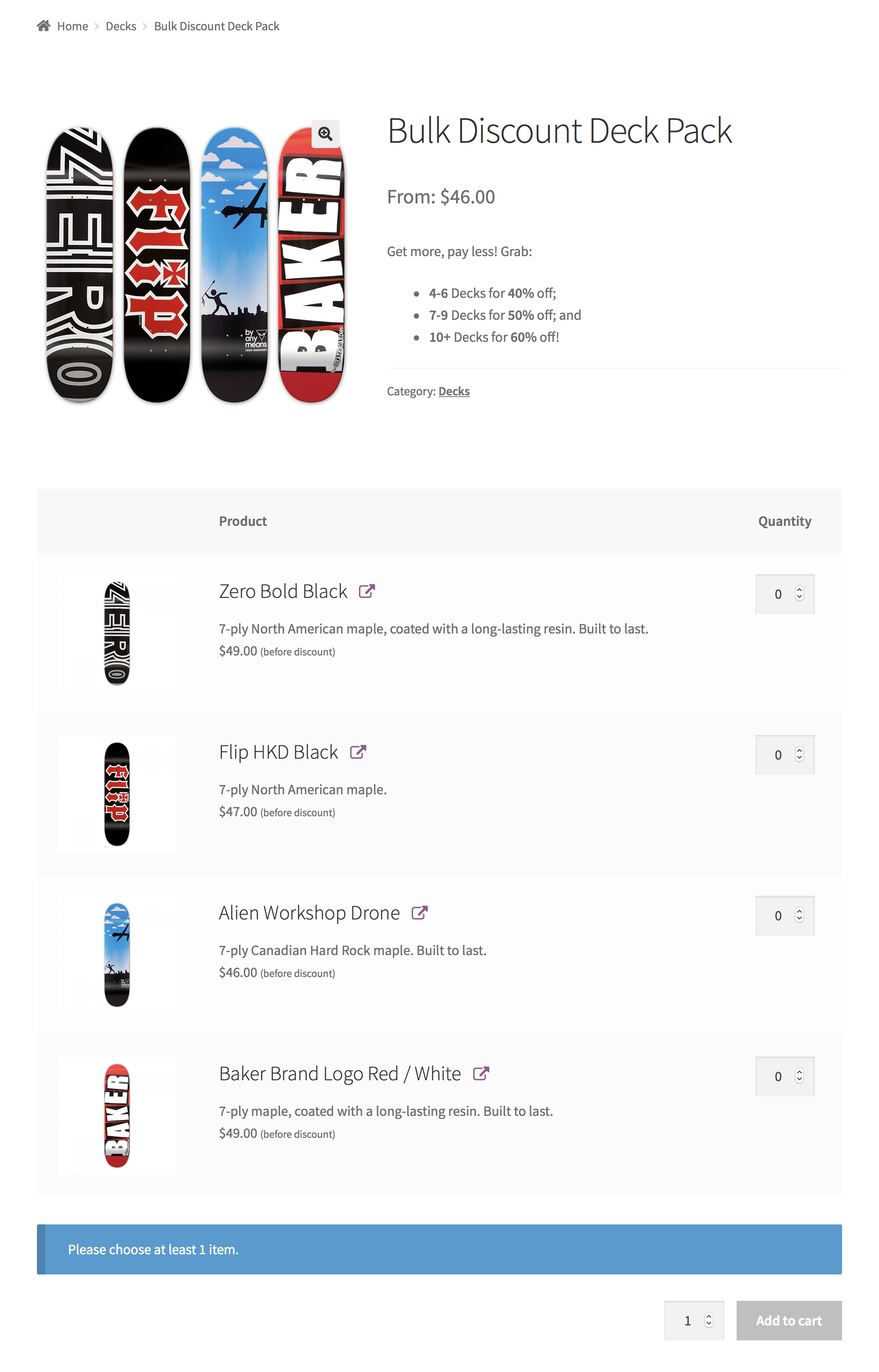



Notes
All products contained in a bundle must have a price set, even when Priced Individually is disabled. WooCommerce does not allow products with a blank price to be purchased
When a Subscription product is added to a bundle, the Subscription product must be Priced Individually if you would like a subscription to be created. Otherwise, the Subscription product will be treated as a one-time purchase (this does not include CRU Club)
Shipping
Introduction
From a shipping perspective, WooCommerce products are classified as:
- Physical (non-virtual) — products that need to be physically shipped or picked up.
- Virtual — services or digital items that do not require shipping.
Product bundles can contain both physical and virtual products. However, their most significant shipping property is whether they require assembly or not. Consider this example:

Therefore, from a shipping point of view, physical bundles are classified as assembled or unassembled:
- Assembled bundles consist of multiple products that are physically assembled in a common container.
- Unassembled bundles group together some products that do not require assembly.
Configuration
To configure a bundle for shipping, follow these steps:
- Determine if the bundle you are creating is an assembled, unassembled, or partially assembled one:
- Assembled bundles, such as the build-to-order Woo Basic PC we saw earlier, are shipped in a single box.
- Unassembled bundles are collections of products that do not require assembly. Their shipping properties (weight, dimensions) are preserved.
- Partially assembled bundles have a common physical container. Some bundled items are assembled in it, and some are shipped in their original boxes.
 Bundles that consist of Virtual products fall into the Unassembled category.
Bundles that consist of Virtual products fall into the Unassembled category. - Assembled bundles, such as the build-to-order Woo Basic PC we saw earlier, are shipped in a single box.
- Navigate to the Shipping tab in the left menu, and choose a Bundle Type. There are two options to choose from: Assembled or Unassembled. If your bundle is a partially assembled one, choose the Assembled option at this point.
 Choosing a Bundle Type: Assembled or Unassembled.
Choosing a Bundle Type: Assembled or Unassembled. - If you selected the Assembled option in the previous step, go on and configure the Weight, Dimensions and Shipping Class of the common container.If your assembly has a static weight, choose the Assembled Weight > Ignore option. If you prefer to calculate its weight dynamically, choose the Assembled Weight > Preserve option. When Preserve is selected, the Weight field is treated as a container weight, and the weight of the assembly is calculated by adding:
- the specified container Weight; and
- the weight of all assembled bundled items.
- the specified container Weight; and
- If your bundle is partially assembled, go to the Bundled Products tab and enable Shipped Individually for every bundled product that does not require assembly.
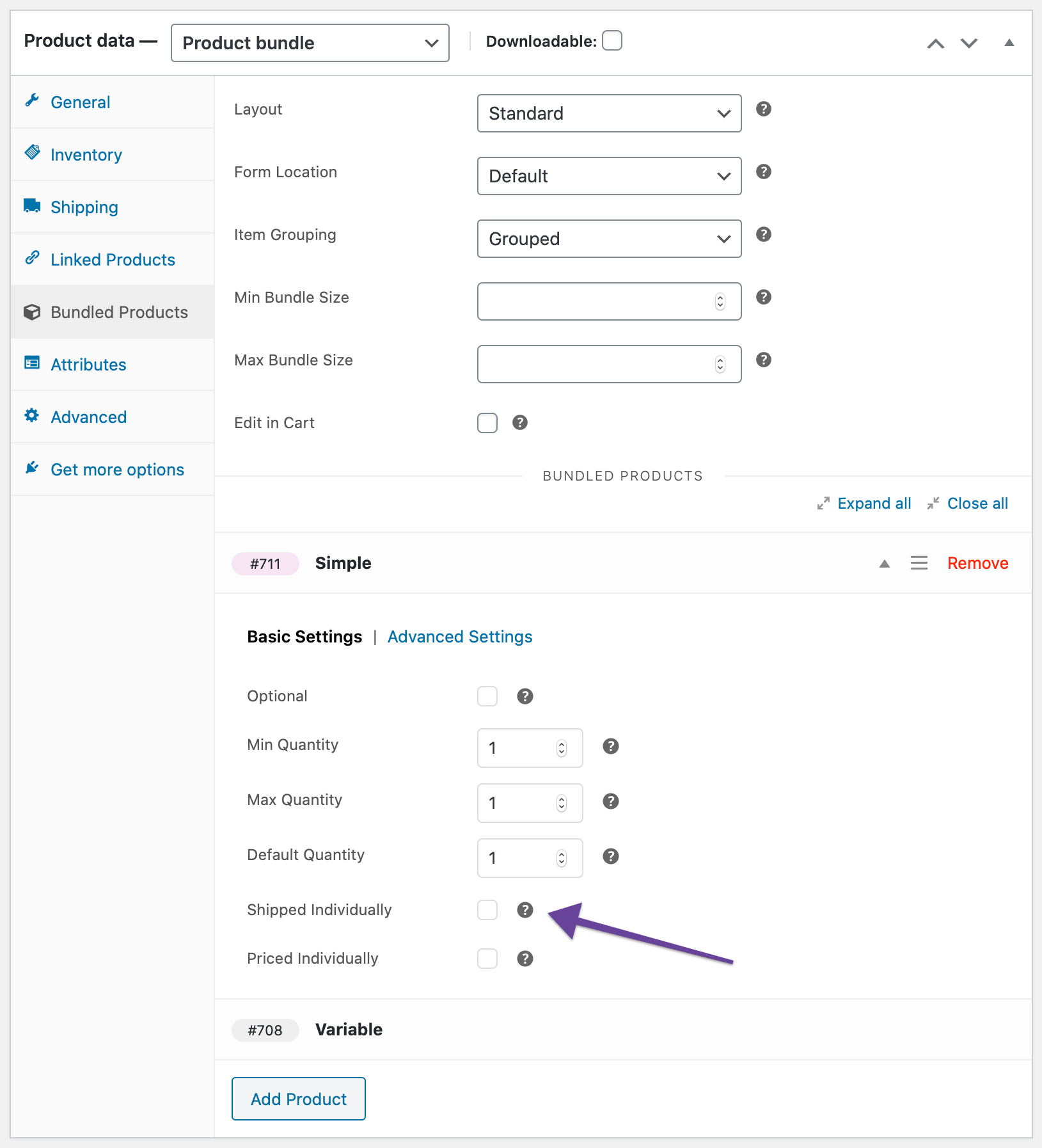 The Shipped Individually checkbox.
The Shipped Individually checkbox. Shipped Individually does not mean “split across different shipments”. For example, a Desktop PC may include some assembled parts, but it may also come with an external monitor that is shipped in its own box, in the same shipment. In this scenario, the monitor will need to be set up as Shipped Individually.
Shipped Individually does not mean “split across different shipments”. For example, a Desktop PC may include some assembled parts, but it may also come with an external monitor that is shipped in its own box, in the same shipment. In this scenario, the monitor will need to be set up as Shipped Individually.
Notes on External Order Fulfillment, Shipping and Inventory Management Services
The shipping configuration options of the Bundle type allow shipping methods and other business logic that relies on the WooCommerce Shipping API to calculate shipping costs accurately.
WooCommerce gives developers a lot of flexibility to customise the shipping properties of the items contained in the cart: When you add an assembled bundle to the cart, it is seen by WooCommerce as a single physical item with an aggregated value and weight. Shipping costs are calculated based on this physical representation.
However, this flexibility is not preserved when working with order data. If you are using an external fulfillment, shipping, or inventory management service that reads order data from WooCommerce, please be aware that an assembled bundle may not be imported as a single item.
Product Bundles provides an API that allows developers to modify the physical representation of your bundles when synchronising order data with external systems. If you require this. Please submit a ticket through our support portal
Bundled Product Settings
Basic Settings
Min Quantity and Max Quantity — Used to define an allowed quantity range for the bundled product: Customers are able to choose any quantity within the specified min/max range. Leave the Max Quantity field blank for an unlimited maximum value.
Optional — When enabled, customers may choose whether to include the bundled product in their bundle or not.
Filter Variations — Makes it possible to make specific variations available for purchase. Applicable to variable products only.
Override Default Selections — Used for overriding the pre-selected attribute values of bundled variable products.
Adding Individual Variations


Priced Individually — Adds the price of the bundled product to the base bundle price. With the option enabled, a Discount can be defined. Both options are documented in the Pricing section.
Shipped Individually — Controls how the bundled product is shipped in relation to the entire bundle (assembled or unassembled) when Bundle Type > Assembled is chosen under Product Data > Shipping. Documented in the Shipping section.
Advanced Settings
Visibility — Controls the visibility of the bundled product: i) in the single product page of the bundle, ii) in the cart/checkout pages, and iii) when displaying order details (including order details displayed in e-mail notifications).

Price Visibility — Controls the visibility of the bundled product price: i) in the product details page of the bundle, ii) in the cart and iii) when displaying order details. Applicable when Priced Individually is ticked.
Override Title and Override Short Description — Used for modifying or hiding the original titles and/or short descriptions of bundled products. Note that overridden product titles will replace the original product titles in all template locations, including the cart/checkout and order details.
Hide Thumbnail — Controls the visibility of bundled product thumbnails, displayed by default when viewing the single-product details page of a bundle.
Layout
The Layout option controls the appearance of bundled product details in single-product pages. There are 3 alternatives to choose from: Standard, Tabular and Grid.
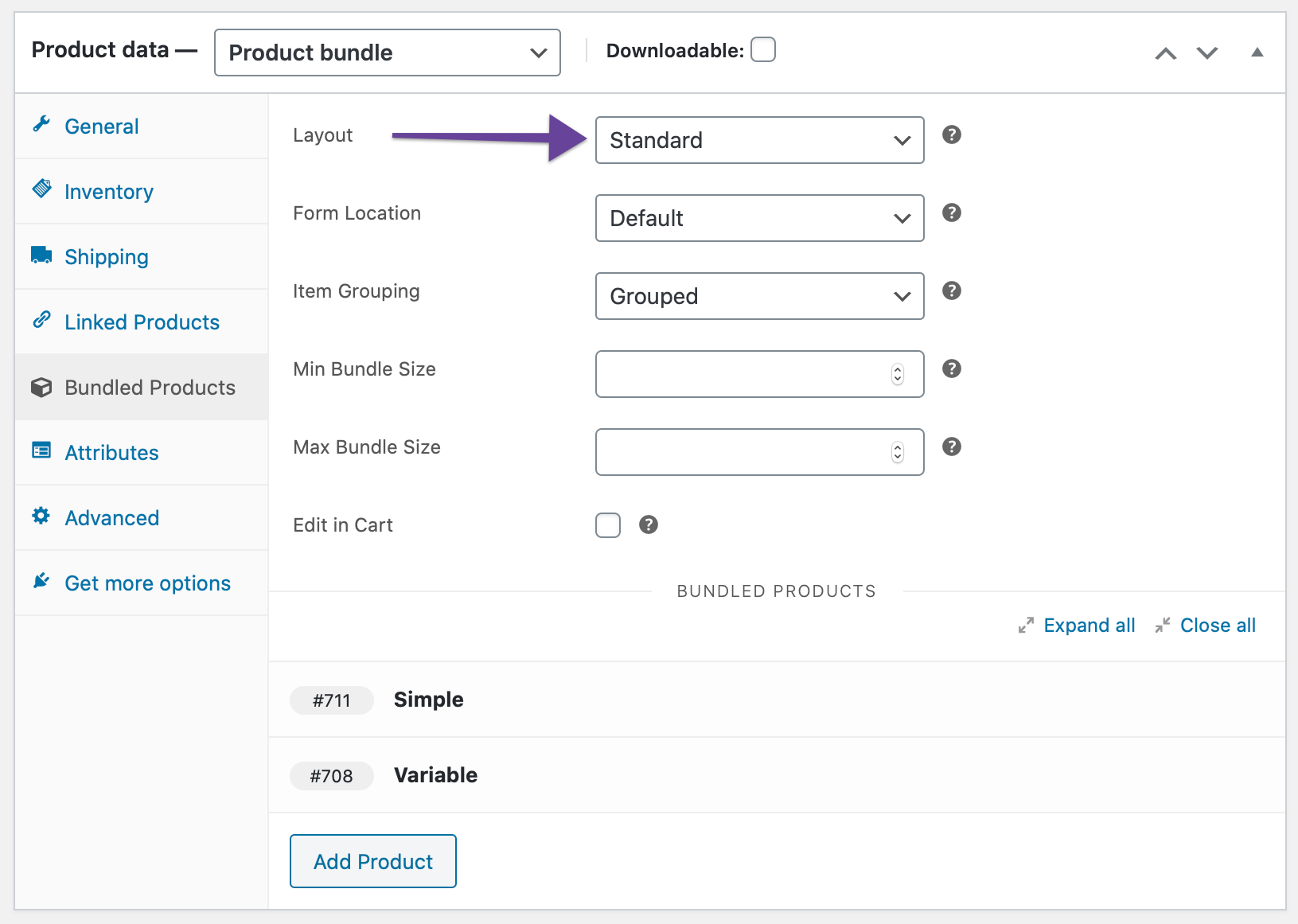

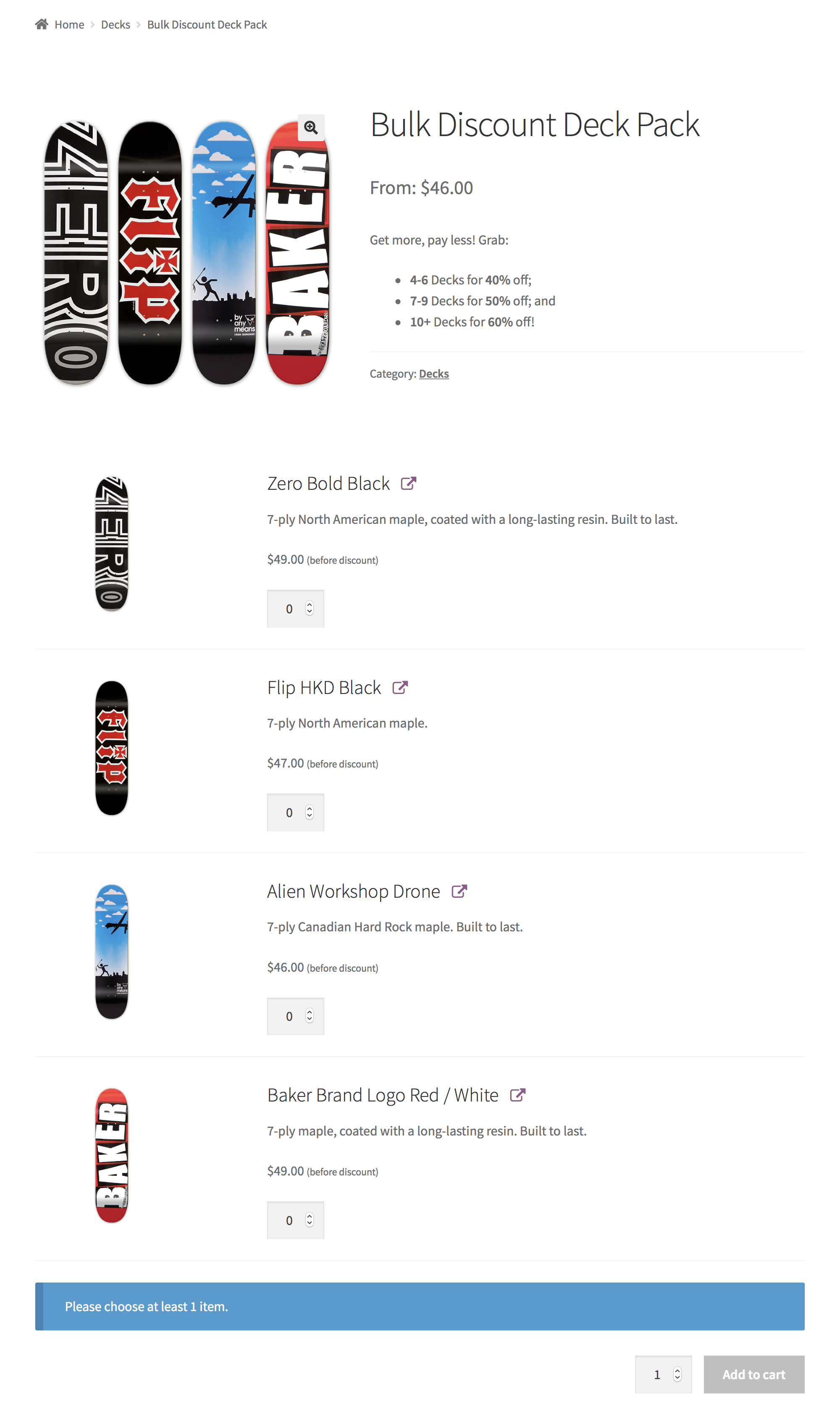

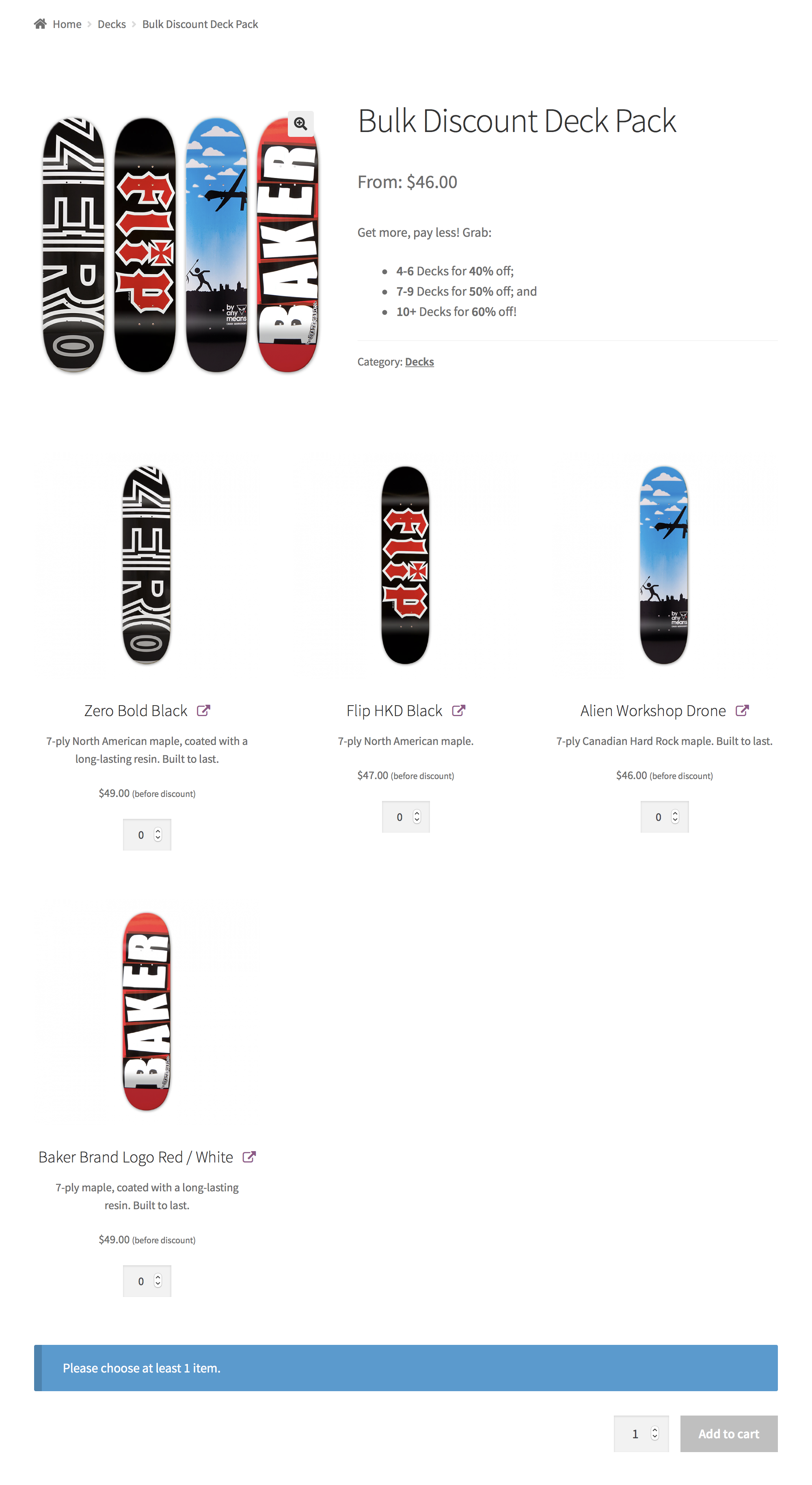
Form Location
Most WooCommerce-compatible WordPress themes default to a two-column product page layout: The first column contains the main product image and gallery, while the second one is reserved for product details and options. This space-conserving approach works well for Simple and Variable products, which usually contain only a few form elements.
Product Bundles tend to have busier forms that require multiple steps/interactions to complete. Sometimes you may find that your theme’s two-column layout makes Product Bundles look space-constrained and hard to interact with. Some themes may allow you to modify the layout of individual product pages to display product details and options in a single column. Please raise a ticket with CRU if you require any changes.
- allocating more width to product form content, or
- stacking product form content below the main product image and gallery.
If you are experiencing layout issues with a Product Bundle and your theme does not provide any per-product layout options:
- Navigate to Product Data > Bundled Products.
- Locate the Form Location option.
- Choose Before Tabs to stack form content after the product image and summary.

Item Grouping
The Item Grouping option controls the visibility and indentation of parent/child line items in cart/order templates:
Grouped — Bundled items in cart/order templates are grouped under a parent line item named after the product bundle itself. Bundled items are indented and bundled item quantities are kept in sync with the quantity of their parent. Must be selected when creating assembled bundles and/or bundles with a base price.

Flat — Similar to Grouped, however instead of being indented, bundled cart/order items include a reference to the bundle they belong to.
None — Hides the parent item in all cart/order templates. Bundled cart/order items include a reference to the bundle they belong to. Makes Bundles resemble Grouped Products in all customer-facing templates.




Bundle Size
To create a pick-and-mix bundle, use the Min Bundle Size and Max Bundle Size options to define the minimum and/or maximum quantity of products that customers must choose to purchase their personalised bundle.
Cart Editing
Configurable bundles, such as the Bulk Discount Deck Pack bundle, can be edited from the cart page by enabling the Edit in Cart option.

When Edit in Cart is enabled for the Bulk Discount Deck Pack bundle, an additional “Edit” link is appended to its title in the cart. Following this link allows you to reconfigure the bundle using its current configuration as a starting point. When finished, click Update Cart to replace the configuration in your cart with the new one.

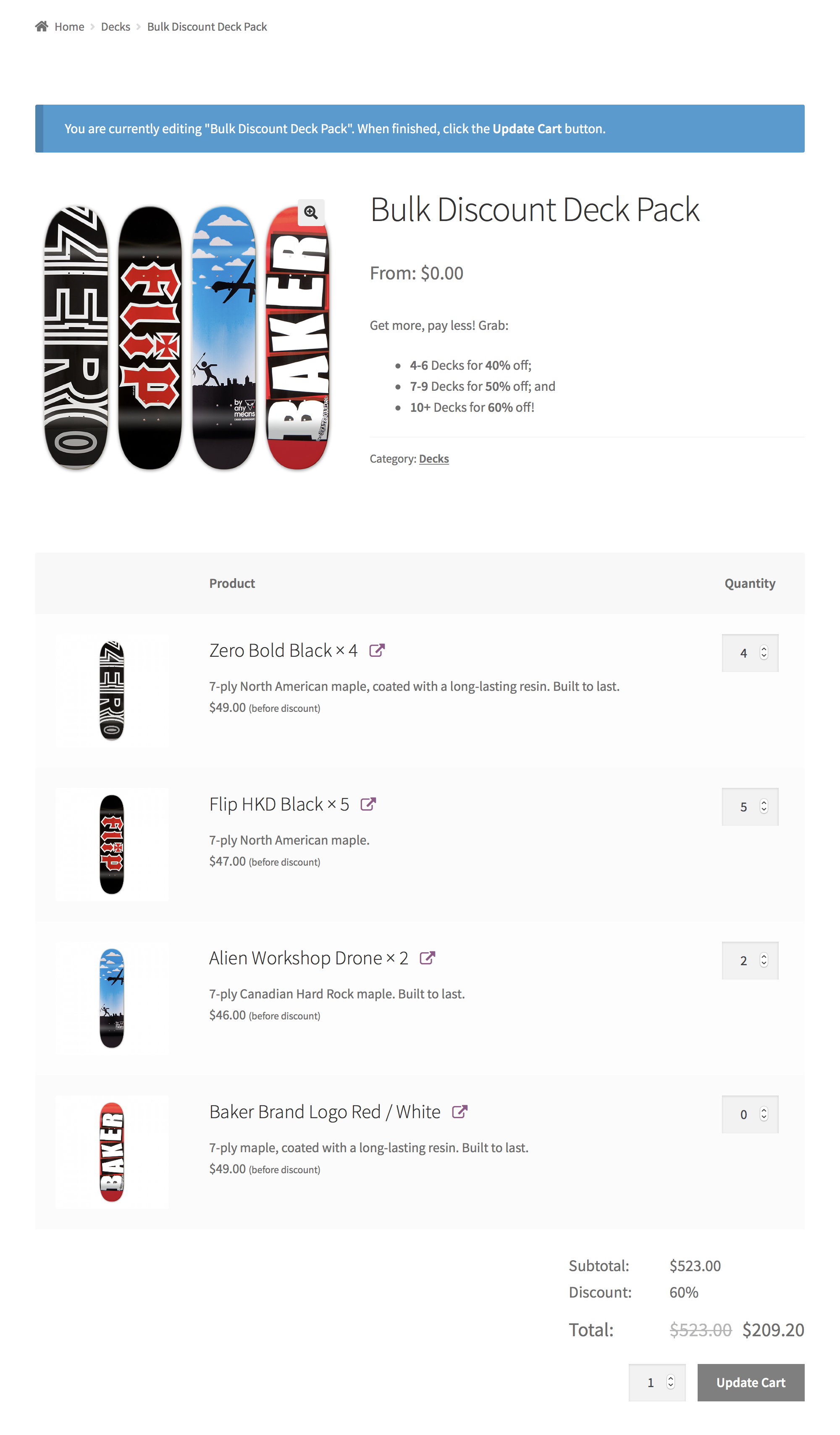
Bundle-Sells
You have probably seen bundle-sells before: Much like a cross-sell, a bundle-sell is an offer to purchase a helpful add-on along with the currently viewed product.
Compared to cross-sells, bundle-sells are easier to discover and convert immediately. This makes them ideal for recommending optional items that are:
- frequently bought (and tightly coupled) with the viewed product;
- lower in cost; and
- usually high in margin.
Product Bundles lets you add bundle-sells to any existing product:
- Go to the Products admin page.
- Edit a product that you consider a good candidate for offering bundle-sells.
- Go to Product Data > Linked Products and locate the Bundle-sells field.
- Search for an optional product to recommend and add it.
- Repeat, if needed.
- Enter a Bundle-sells title below, e.g. “Frequently Bought With…”.
- Optionally, to provide an extra incentive, enter a Bundle-sells discount.
- Remember to Update the product to save your changes.

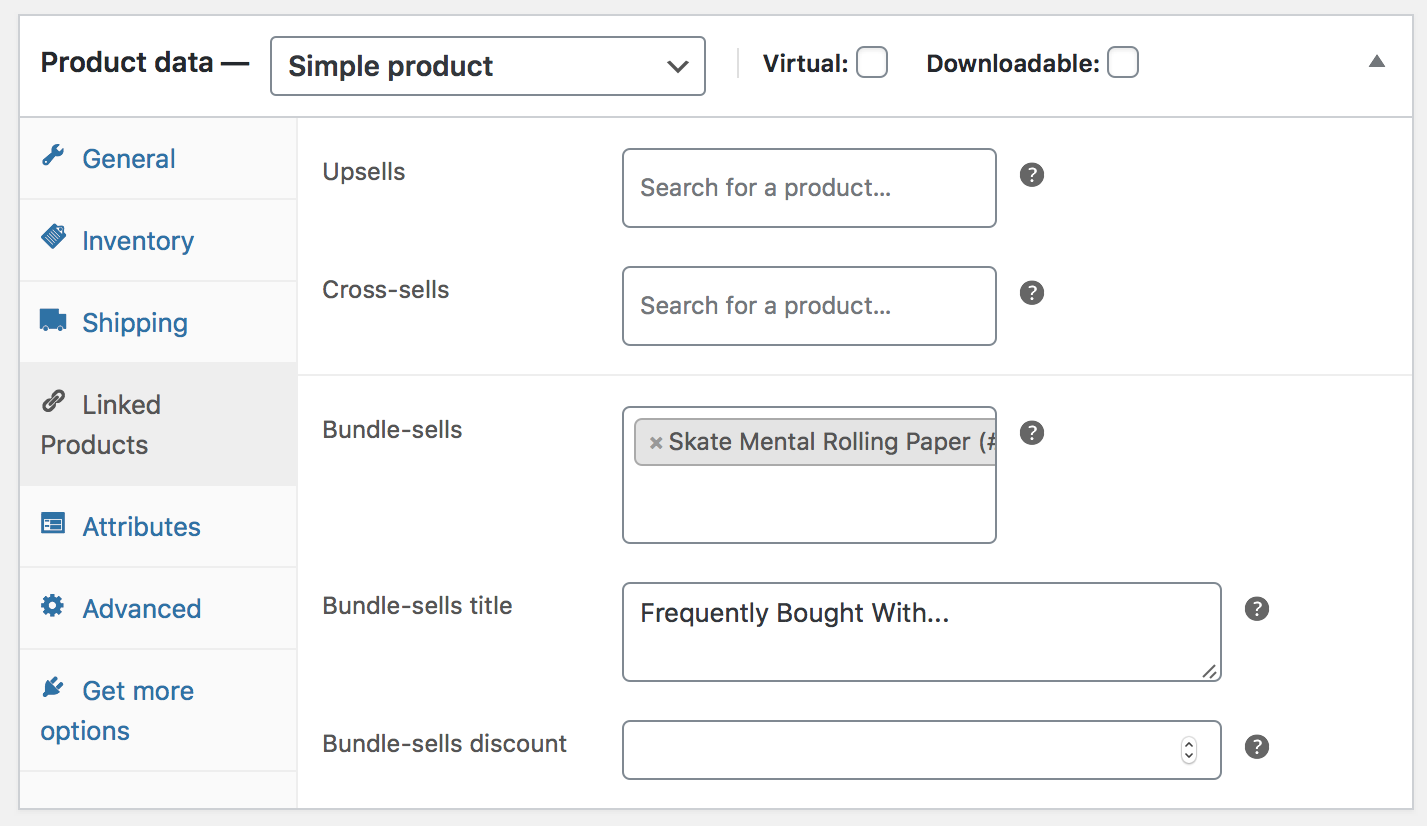
Managing Inventory
The sale of a product in a bundle has the same effect on its stock as an individual sale. If the stock quantity of a bundled product drops below the minimum quantity specified in the bundle, then the bundle appears with an Insufficient Stock status and cannot be purchased.
Monitoring Bundled Product Stock
A product appearing as In stock in your catalogue may not have enough stock to cover the requirements of every bundle that contains it. For example, if the Minimum Quantity defined for a bundled product in one or more bundles is higher than its remaining stock, then these bundles will not be available for purchase.
To monitor bundled product stock, navigate to WooCommerce > Reports > Stock > Insufficient stock. This report gives you an overview of all products you have added in Bundles that fail to satisfy the stock/quantity requirements of their container.
Inventory Settings
The sale of a product in a bundle has the same effect on its stock as an individual sale. Product bundles that contain items with insufficient stock appear with an Insufficient Stock status and cannot be purchased.
At the same time, bundles can have their own SKU, and manage inventory for it. The ability to manage stock at bundle level is useful if a limited resource prevents you from assembling or fulfilling an unlimited number of bundles within a given period. For example, if you decided to sell complete skateboards, you would quickly notice that the number of skateboards you can ship every day depends on: (i) the time it takes to assemble a skateboard, and (ii) the size of your fulfillment team.
 Overview and pricing of this feature. Click here
Overview and pricing of this feature. Click here

 Troubleshooting this feature? Click here
Troubleshooting this feature? Click here

Related Articles
Product Bundles - Features
View Guide Links at the bottom of the page Installation 1 CRU CREDIT Setup (optional) 1 CRU CREDIT Ease Of Use Easy Want this feature? Request Here Purchase CREDITS Here Meet Product Bundles: A beautifully-crafted WooCommerce plugin that covers ...Product Bundles - Troubleshoot Guide
How to set the weight of the bundled product If there's no weight declared on the individual products inside the bundle then don't tick this tick box so that the system will use the weight declared on the bundle product. If each products has weight ...Adding and Managing Products
Adding a product Before adding your first product, let’s get familiar with how product categories, tags, and attributes work. Product Categories Product categories and tags work in much the same way as normal categories and tags you have when writing ...Product Bundles - User Guide
For pricing and how to add to your website see at the bottom of the page. Creating Bundles To create a product bundle: Go to Products > Add New. Select the Product Bundle type in the Product Data panel. Go to the Bundled Products tab. Click Add ...Basic Woocommerce - User Guide
For pricing and how to add to your website see at the bottom of the page. Adding and Managing Products Adding a product Before adding your first product, let’s get familiar with how product categories, tags, and attributes work. Product Categories ...

